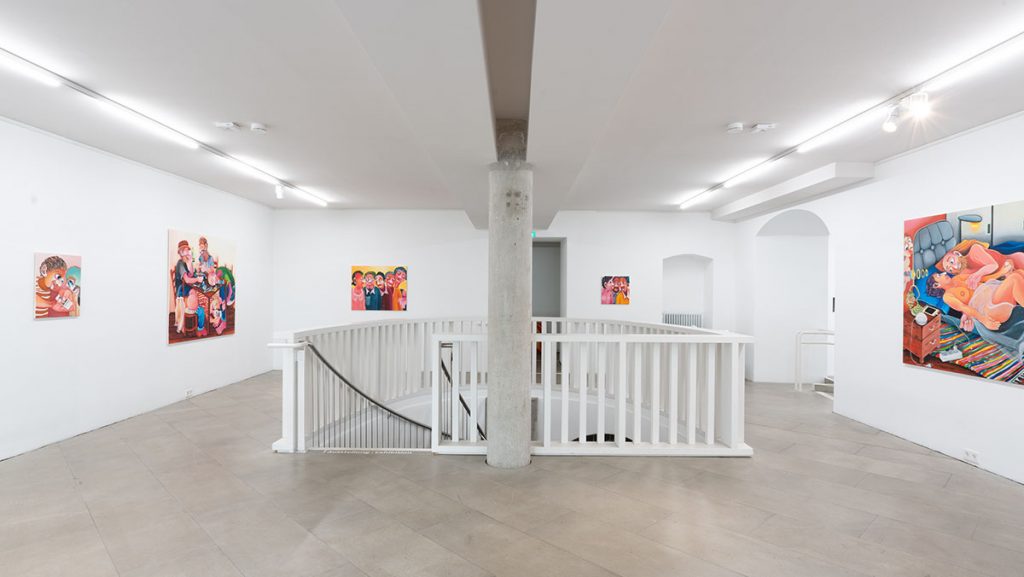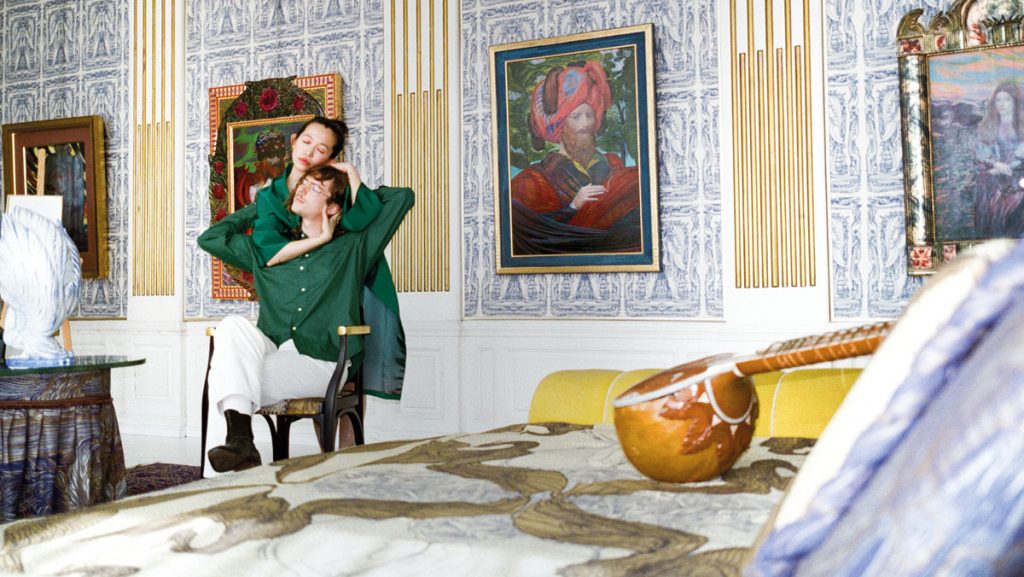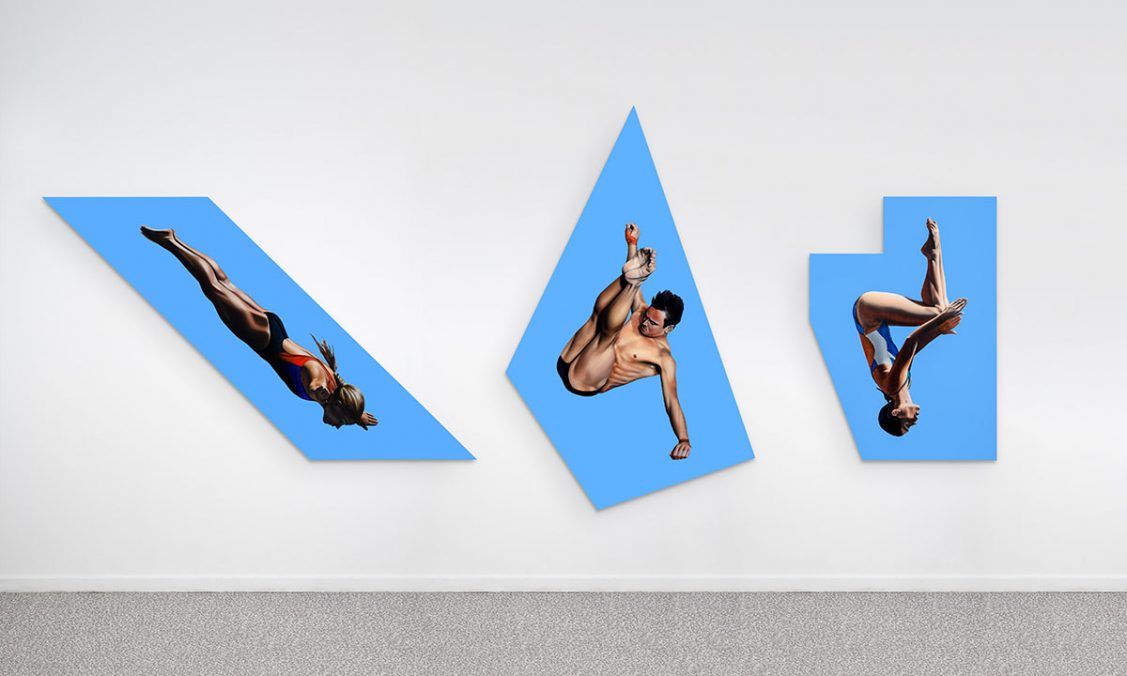
The myriad of shaped canvases, together with exhibition views and details from his series `The Springer ́ awaken in me the interest to delve deeper into his art. During the last years, the inspiration for his works mostly doesn’t come anymore from the analog realms. Instead, inspirations and motifs derivate from the digital space. The online collected images have in this way the character of an object trouvé. The artist relies on the magic of the web and has learned to delegate to it parts of his working processes. In the second part of the day, Eggers is occupied with transferring these images into oil paintings. Is it perhaps also a way to make this online world, which in itself has a certain Vergänglichkeit immortal? *the choice of hyperconnected as a word is inspired by „The Onlife Manifesto“ book, Luciano Floridi (Ed.)
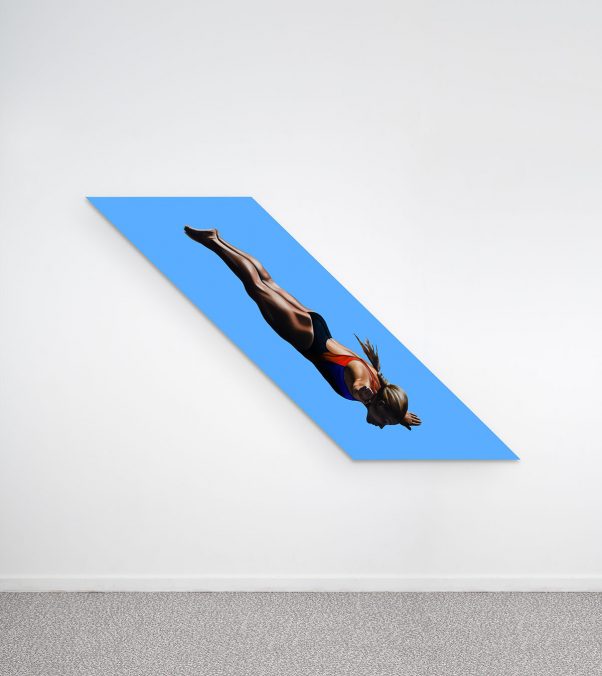
Thorben Eggers, Turm 3, 2018, oil on canvas, ca. 125 x 207 x 4 cm verso signed 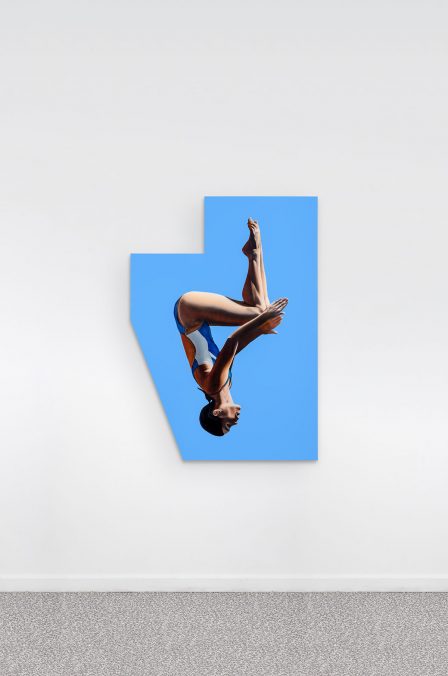
Thorben Eggers, Turm 1, oil on canvas, 143 x 100 cm, 2018. Studio Düsseldorf, Photo: Thorben Eggers 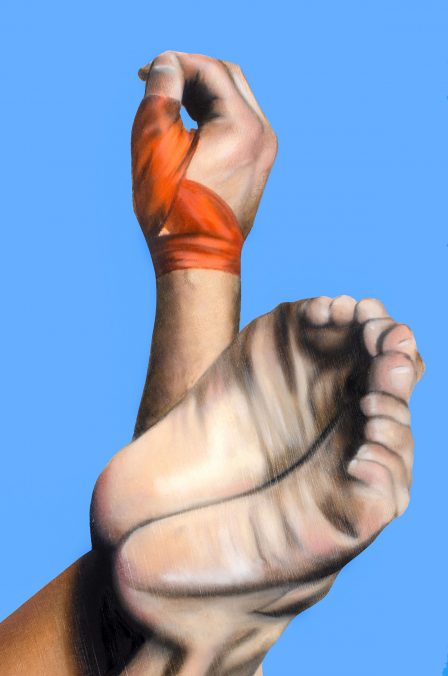
Thorben Eggers, Turm 2 (detail), oil on canvas, 195 x 125 cm, 2018 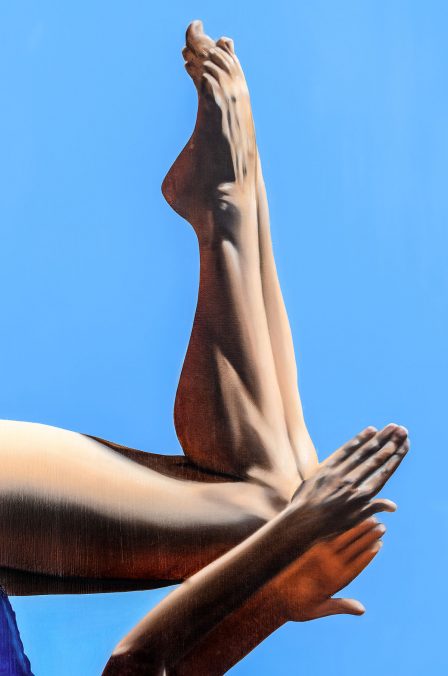
Thorben Eggers, Turm 1 (detail), oil on canvas, 143 x 100 cm, 2018. Studio Düsseldorf, Photo: Thorben Eggers
How did you come into art? Was the philosophy studies or the art ones coming first?
I started in my studies with art (2009) and then a year later (2010) started also to study philosophy. Already as a teenager I was interested in art and spent a lot of time with graffiti, later with acrylic, and finally with oil paints. Meanwhile with philosophy, was a bit different – I only became more interested in philosophy during my studies.
Only there, in the microcosm of the art academy I realized that a large part of my questions touch on philosophical contents. „What is a picture and how do we perceive the outside world“ are aesthetic questions that were already discussed in philosophy.
The paintings of the Springer_series are the very first works that I have seen from you. I was attracted by the geometry of the canvases and the kind of strictness that the human bodies demonstrate in this series. I’d like to ask you to go more thoroughly into these paintings.
My involvement with skiing and high diving came rather by chance. I saw a picture of a ski tour in the newspaper one morning, which is quite popular in Germany – but honestly never interested me personally. Suddenly, however, there was a moment when I paid attention to the shape of the figure in the air: How acute is the angle of the outstretched skis and arms, what contrasts are formed by the clothing and what perspective is most exciting for an image. Thereupon I did further research and I found it remarkable with which body tension these athletes fly through the air. I was also interested in the tense bodies with their hardened muscles of the high diver, so that I began to develop a small series from it. All jumpers define the outer shape of the canvas through their posture and float in front of a monochrome blue background. On the one hand, the color reminded me of a radiant blue sky, on the other hand, it also reminded me of a bluescreen, which is used for image processing. In this way, the figures oscillate between exact depiction and simultaneous uncertainty on the part of the viewer as to whether it is a photograph or a simulation after all.
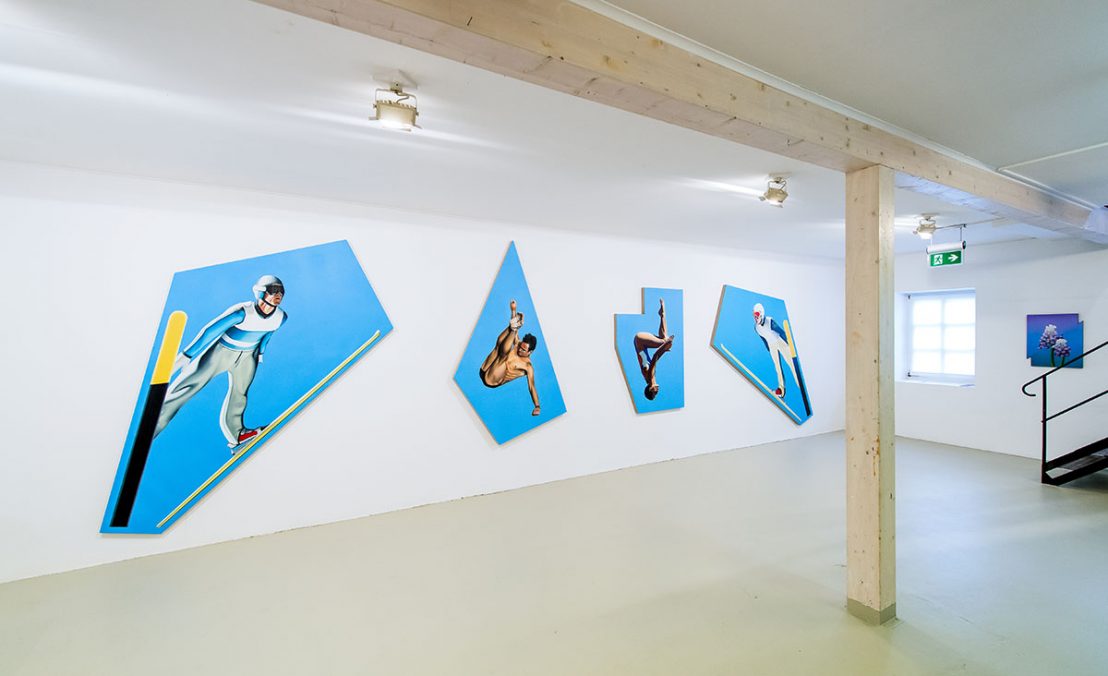
How is your work created? Do you have any themes that you keep examining?
I tried to work as freely as possible during my studies. But I tried myself parallel to the free work on very photorealistic works and purely abstract color surfaces. I feel that through shaped canvas I can bring the two poles together in one form. For a long time I worked with fashion photographs from advertising brochures or the Internet. This interested me in terms of the idea of simulation; we all know how heavily these images have been edited in Photoshop. Nevertheless, we feel a certain attraction to be inspired by new trends. So the images are per se already artistically charged, because for me they reflect a certain unnatural image of people. Not as an advertising aspect, but rather as a projection surface of a society wanting to surround itself with simulations, because these seem more beautiful than reality. At the same time, there are also other aspects, which have played a role in why I worked figuratively for a long time. That time my studio in Düsseldorf was located on a side street of Königsallee which is one of the most expensive shopping streets in Germany, one of those streets where you see expensive cars everywhere, and where all luxury brands have opened a store. In order to reach my atelier, I had to cross always this street, and once doing the first step in my workplace, I started to ask myself: „What is this all about out there?“
When do you consider a painting finished?
When the computer generated image surprises me as a template and I feel a satisfaction to have painted it.
How important is for you the presentation of the artworks in an exhibition?
The exhibition concept has become an increasingly important concern to me. The serial way of working and the pictures that have been created in that serial arrangement should not be torn apart. Therefore, already at the beginning of an exhibition situation, I start to consider all these things, I ask myself: „To what extent new series of pictures can be developed further, and how do they work on the exhibition walls?“ In order to do this, I use always a digital model for myself, I hang my works, play, try out several variations. In the end, we will have an exhibition idea that emerges partly from the digital and then is transferred to the real space. In addition, wall installations are lately playing a greater role. In the Kunstverein Mönchengladbach, I had to perform on a 16 x 4 meter wall, that time I came with the idea to connect the individual images through their color surfaces. Meanwhile, in the exhibition – Separate Reality – I provided mirrors to the walls – in this way, the image gained the possibility of going into infinity. I’m interested in this scalability of spatiality, especially since the idea of the endless „copy and paste“ mentality is strongly anchored in us digital natives.
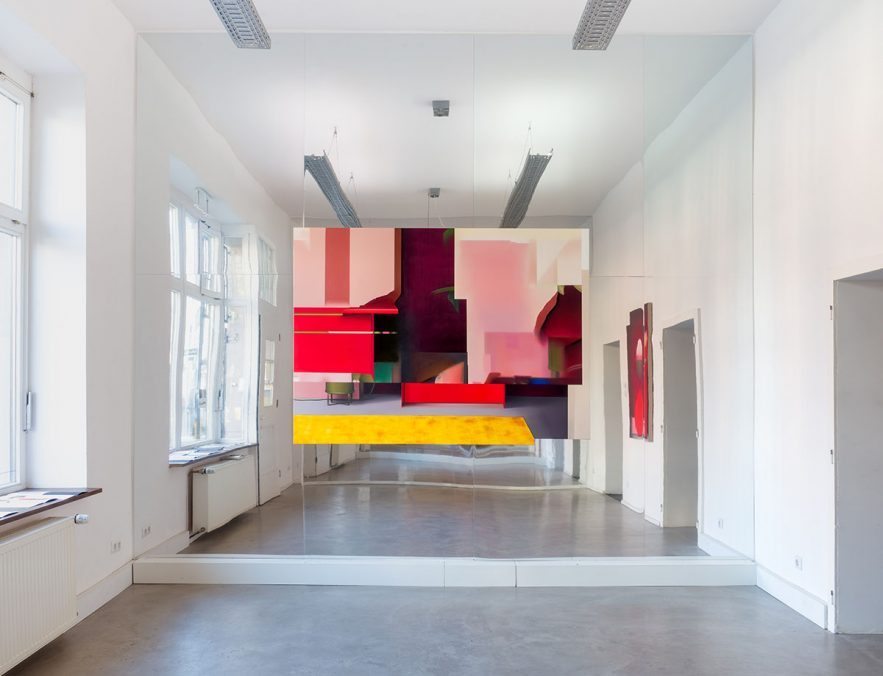
Thorben Eggers, Exhibition view, Separate Reality, Coelner Zimmer, Düsseldorf, 2021. Photo: Thorben Eggers 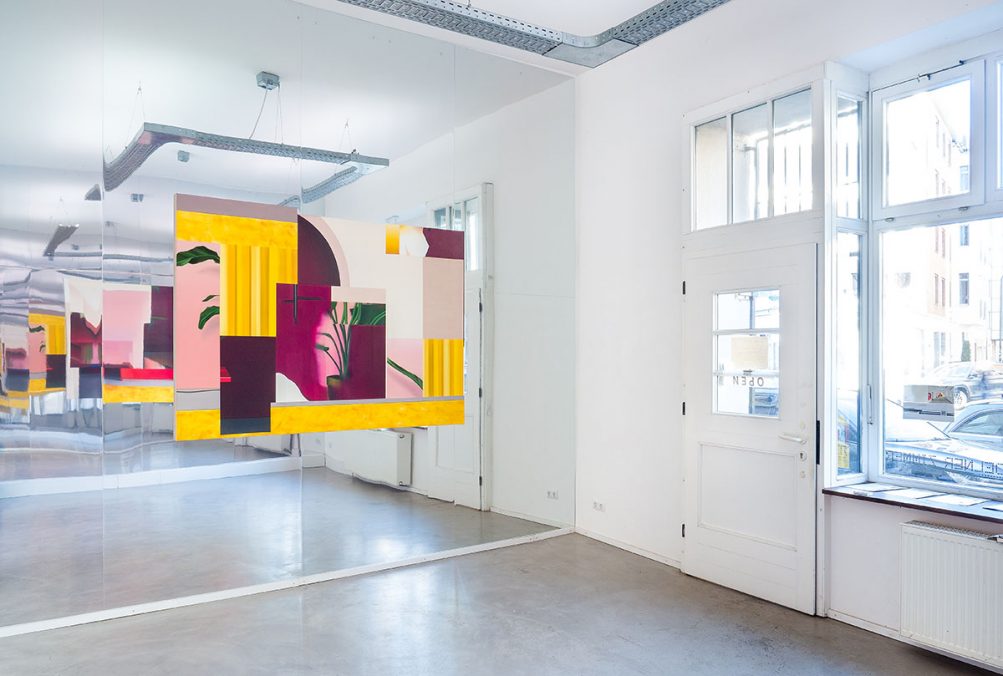
Thorben Eggers, Exhibition view, Separate Reality, Coelner Zimmer, Düsseldorf, 2021. Photo: Thorben Eggers 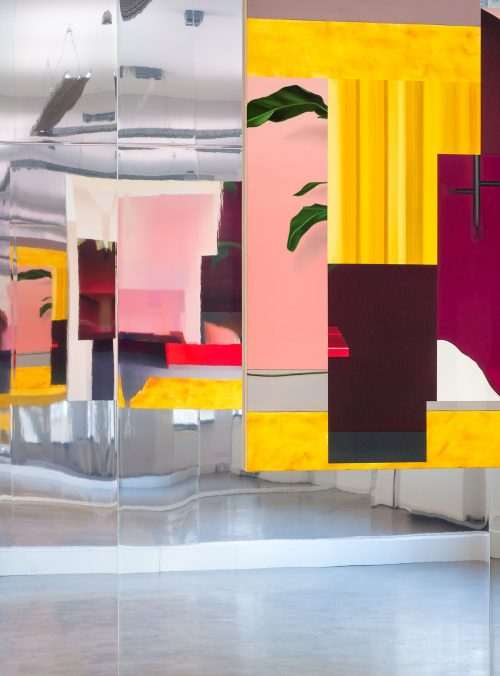
Thorben Eggers, Interior_2, oil on canvas, 154 x 210 cm, 2020. Solo Exhibition, Coelner Zimmer, Düsseldorf, 2021. Photo: Thorben Eggers
Your works are usually developed in the digital world, then you veer them into oil on canvas paintings. I wonder what happens during these transformations and if a day the digital versions could also be shown independently?
For a long time, I have actively designed the transformations by myself, in my earlier works I used to decompose certain figures analogously, with scissors and paper, then re-assembled them in a new way and ultimately turned them into oil paintings. Over time, the process has been shifted to a digital one, because there I have more leeway, for example, to copy, scale and reassemble certain parts of the picture.
I have the feeling that with time I have withdrawn myself more and more from this role of active image creator, and I have been delegating it to the artificial intelligence.
I now define only certain areas of the image, which are then moved randomly or recalculated based on the surrounding pixels. This way of working is particularly interesting for me. I don’t know at the beginning what the final product will look like, so I see this moment of surprise as a genuinely creative process of my work. The content of the original image is no longer anchored in the usual mode of representation -as an image-, but consists only of the calculation of the new pixels of the image processing program and thus appears to us as a new image surface. At the same time, I realized that a simulation does not fully satisfy us as humans, because we long for originality and individuality. This is maybe why I have decided to paint the digital images – it is a way to bring myself as a human being into the whole. The digital background remains recognizable, but at the same time, has quasi an auratic sense. The presence of the human being can be felt in and behind the image. I can quite imagine processing the digital designs, but the simulation alone, without my painterly process, wouldn’t be a full-fledged artwork. On that case, I would always feel the need to inscribe my human being defectiveness analogously.
The metadata of artworks, e.g., the captions are often important not only to the artist him/herself, but also to other “interested party“ (gallery owners, dealers, curators, audience). I find your titles very striking. Some look very descriptive (Transformation, Interior, Conversation 2), others look like if they would reveal what has happened during the artistic processes (Search Result 2), and then there are other titles like SBF2, which feel completely cryptic. What role does language play for you, and how do titles evolve?
I think a lot about titles, and at the moment, I can’t imagine an artwork without a title. With the title, you can steer viewers in a certain direction – which either leads them to the image, or distracts from the actual image interpretation. What all my titles have in common is that I don’t use big narratives or sentences, but that they are mostly limited to terms. For example, the title series „Transformation“ refers to the image process – a command in Photoshop is also called like that, whereas the title „Conversation“ is meant to be a reference to the image content. There, cropped portraits, as well as a telephone receiver appear – inviting communication, and evoking a possible conversational situation in the viewer*s mind. Other titles, such as „SBF“, sound cryptic, and are based on the degree of abstraction of the images: for example, the series „SBF“ refers to boats that are fragmented to such an extent that one can no longer make out the original form. „SBF“ in turn, stands for an abbreviation of the sport boat license in German- speaking countries and is also a conceptual abstraction that cannot be deciphered at first glance or for many viewers. At the same time, for example, in the „Interior“ series, I began to label the images with numbers and underscores. The analytical way of sorting files on the computer and marking them with certain additional characters to make them easier to find inspired me to title my artworks similarly in this aesthetic form and to apply the same sorting patterns to my artworks. In this context, I also find a future perspective quite exciting. To what extent will these titles be interpreted in 50 or 100 years as a mirror of the present time?
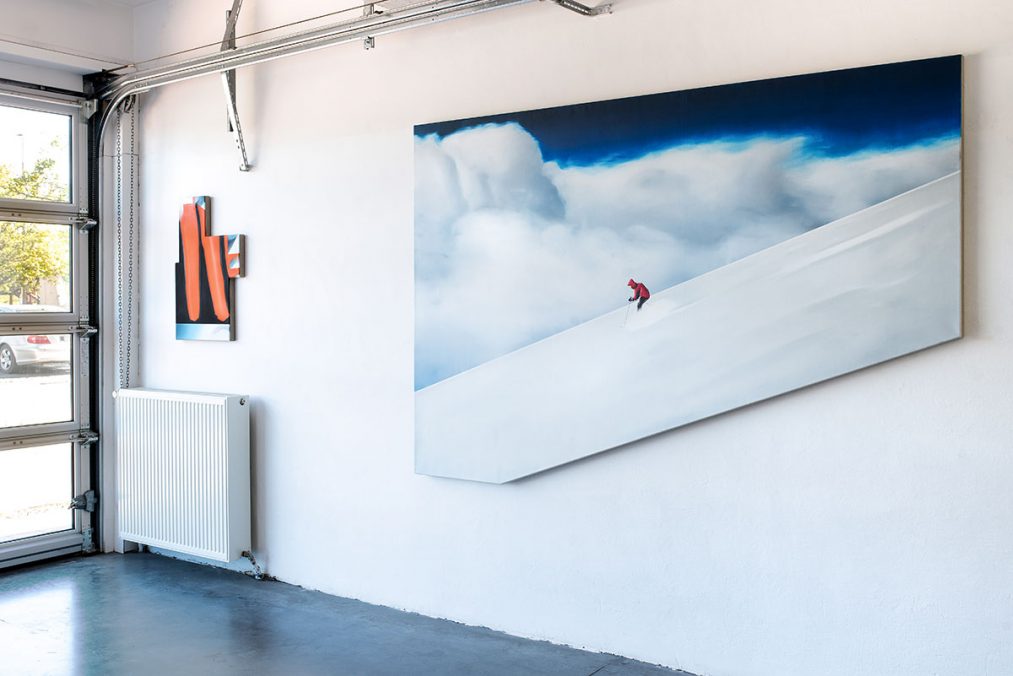
From left to right: Thorben Eggers, Transformation_3, oil on canvas, 83 x 57 cm, 2019 | Abfahrt, oil and lacquer on canvas, 170 x 250 cm, 2017. Solo Exhibition, Front Room, Tatjana Pieters Gallery, Gent, 2020 Photo: Kelly Van Looveren 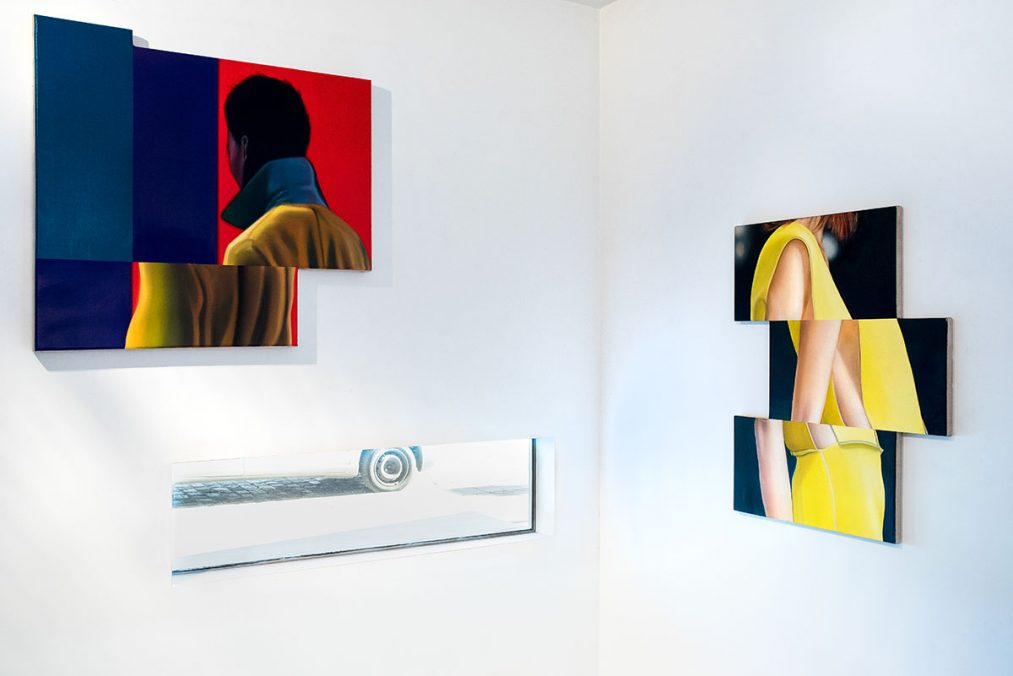
From left to right: Thorben Eggers, Suchergebnis 6, oil on canvas, 80 x 73 cm, 2019 | Thorben Eggers, Gelb, oil and lacquer on canvas, 72 x 60 cm, 2017. Solo Exhibition, Front Room, Tatjana Pieters Gallery, Gent, 2020. Photo: Kelly Van Looveren
I would like to return briefly to the format of your canvases. How are they constructed? And are there any other artists in distant or recent history who have built up their canvases in a comparable manner?
It was only in 2015/16, that I began to question the format of the image, the medium for representing paintings. Before reaching this phase, I was always more concerned on questioning the content of the image, by leaving the outer form untouched. In the digital images of a user interface of a PC, different windows lie on top of each other, resulting in shadows, sometimes pop-ups appear, and overlay on the image content – I endeavored to transfer this digital impression into physical space as well. Then, of course you start also to research the extent to which art history has already contributed to this question. There is a great tendency in American abstract painting to take up such shaped canvases, as in the work of Ellsworth Kelly or Frank Stella, for example. Often, however, the content of the picture is also abstract, and my way of working is captivating in that it attempts to combine representational motifs and abstract forms in the picture. Some pop artists like Tom Wesselmann or Alex Katz have created some figurative paintings that cannot be assigned to a classical picture format – but there, the pictures functions more as a detail and do not correspond to a conceptual idea of picture formats as I strive for. I build the canvases myself, because then I have the greatest leeway to add or remove certain forms from the images. At the same time, I strive to make each image both technically and craft-wise better, which in the last series, I have been succeeding.
Looking at your work, I have the impression that in your earlier days human characters were more present. Can you disclose where you used to be looking for them?
People used to take a stronger role in my paintings. Most people are from advertising brochures or from the Internet, because I find it exciting to take images that are already circulating publicly. Then, when discovering my art, people consciously or unconsciously remember certain image patterns, which are familiar to them from everyday life.
How does a day start?
I’m actually a morning person and get up relatively early to get to work on my art by midday/afternoon. The actual creative process is already completed on the computer, then I go with the finished images to the studio, and implement them with the digital specifications. The work itself is very structured and I know in advance, for example, in which period of time I can paint which color area. I usually work until the afternoon, then it’s family time with my two children.
How has this period of the pandemic been for you as a human, and as an artist?
The corona-related pandemic period went surprisingly well for me. The most important thing is of course that my family and I are healthy and stay healthy, but also during the lockdown I was able to realize many exhibition projects. Unfortunately, I couldn’t go to all the exhibitions or the openings – mostly were cancelled. But with the simultaneous move to Hamburg, I was able to start here with a first solo exhibition in a Hamburg gallery and had my first international exhibition in Ghent a short time later. During the lockdown, I became more involved with architecture and interiors, because we were all more or less locked in.
That is to say, the circumstance did have a lasting influence on my art and I moved away more and more from the figurative orientation in favor of a questioning of interior and exterior spaces.
This is exactly where I would like to continue working at the moment and am planning further works in which interior spaces are digitally processed and artistically thematized.
What are you currently working with?
I’m currently working on new images for interior views, in which I try to question even more the format of the image, work with oval or round shapes, for example, since I’m curious myself, what develops from it.
Thorben Eggers – www.thorbeneggers.com, www.instagram.com/thorbeneggers/



